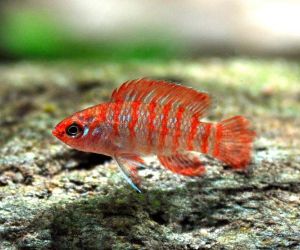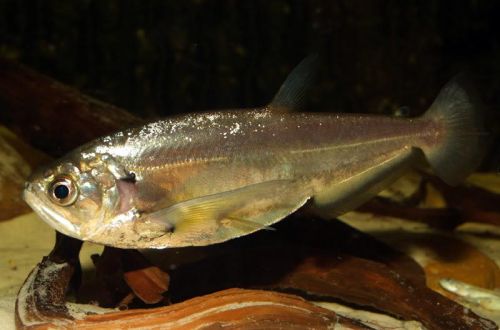
perch discoid
Discoid perch, scientific name Enneacanthus chaetodon, belongs to the family Centrarchidae (Sunfish). Known as Blackbanded sunfish in English-speaking countries.

Contents
Habitat
The fish is native to North America. The natural habitat is limited to the United States. Inhabits river systems flowing into the Atlantic Ocean from New Jersey to central Florida.
Inhabits lakes, ponds, quiet sandy backwaters of streams, small and medium rivers. Found in places with dense aquatic vegetation.
Description
Adult individuals reach a length of about 10 cm. The fish has a high oval-shaped body flattened from the sides. The fins are large, especially in males, translucent. The first rays of the ventral and dorsal fins are thickened and look like sharp spikes. The coloration is gray-silver with rows of six vertical brownish stripes.
Brief information:
- The volume of the aquarium – from 90 liters.
- Temperature – 4-22°C
- Value pH — 6.5–7.5
- Water hardness – 10–20 dGH
- Substrate type – any
- Lighting – subdued
- Brackish water – no
- Water movement – little or no
- The size of the fish is about 10 cm
- Nutrition – live food
- Temperament – peaceful
- Keeping in a group of 5-6 fish
Maintenance and care, arrangement of the aquarium
Discoid perch can live in a fairly wide range of pH and GH values. However, it makes special demands on the water temperature. The fish needs cool water no higher than 22°C. Thus, the aquarium should not be equipped with a heater, and in the hot summer period, additional cooling will be required.
The optimal size of the aquarium for a group of 5-6 fish starts from 90 liters. In the design, it is necessary to provide for areas with dense aquatic vegetation from among cold-water species.
Plants for cool water can be selected in the appropriate section using the filter. Check the box “Cold water plants” in the filter and click the “Hiccup” button.
Maintenance and care are standard and consist of several mandatory procedures: weekly replacement of part of the water with fresh water, removal of organic waste and equipment maintenance.
Food
The basis of the diet is live food. In particular, mosquito larvae, bloodworms, small crustaceans such as brine shrimp and daphnia. Generally does not accept alternative dry food.
Behavior and Compatibility
Peaceful calm fish. Prefers to stay in groups. During the spawning period, when males guard the masonry, they can show aggression towards their neighbors in the aquarium if they are too close. Compatible with many fish of comparable size and temperament, able to live in relatively cold water.
Sources: Practical Fishkeeping, Fish Base





